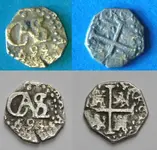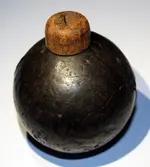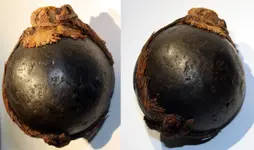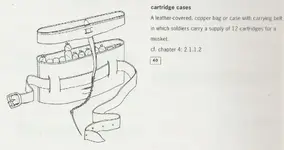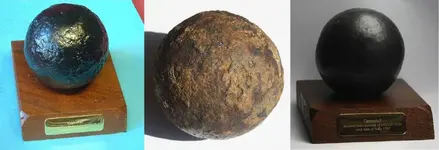Beautiful restoration job and perfect documentation of the process, artifact, and construction materials!
I believe the cast iron was brazed, not welded, hence the softer metal you are encountering.
Cast iron doesnt do well under tension and becomes even more brittle with the stress of the brazing. With these stress fractures, it make it more likely to fracture into small pieces. From what I understand, this wasnt really successful, and the fragments were large, but still better than a complete casting.
There seems to be reference to adding graphite to the cast iron mix to make it better for small piece fracture, and easier to construct and weld. By any chance, did you do a spectrographic analysis of the metal?
An ongoing study
https://exarc.net/issue-2018-01/mm/shifting-sand-replicating-black-powder-grenades
Three artifact collections were utilized for this study; The Queen Anne’s Revenge, the 1715 plate fleet wreck, and the 1733 plate fleet wreck, which together offer a sample size of 60 grenades. A similar shipwreck, the Whydah, established a typology system for grenades, but is too limited in its range of measurements and flexibility to include other collections (Hamilton 1992:277–296). In consultation with Eric Farrell, a conservator at Queen Anne’s Revenge Laboratory, a new archaeometry system of measurements was developed to resolve previous shortcomings. The measurements of the corpus were subjected to a statistical analysis of mean variance to determine average measurements of each feature. Overall, the exteriors of the shells measure 76 mm, with an interior cavity of 50 mm and a fuse hole of 12 mm. These measurements were used as the basis for replicas of both material types.
The sizes represented appear to be close to the size of the grenade that you restored.
I feel that your valuable measurements, especially the wood plug and power weight would be invaluable to this study and reconstruction testing that they are doing. A collaboration of your findings and their testing and reconstruction efforts would be incredibly valuable research.
The results of the study, with historical reference and the test results, (showing damage), may be interest to your friend for valuation purposes!
Afterall, everyone wants to see the kind of damage a munition does!
(what is your native language?)



